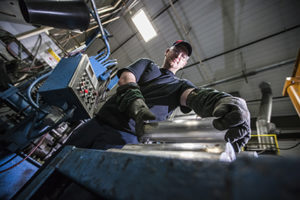When the quality of aluminum extruded products go awry, customer satisfaction plummets.
Recently, we recognized we were struggling with surface-finish defects on a customer’s product based on the number of returns. These returns were frustrating our customer and eating away any profit. Addressing the problem head-on was critical to improving customer satisfaction, and ultimately, building a successful relationship.
To understand the issues from our customer’s viewpoint, we assembled a small team of our experts and traveled to the customer’s location to see the defects and discuss solutions to the problem. During the visit, we learned improper die design and product-handling methods were the primary sources for the issues. Focusing on the sources of the defects, we began working on ways to reduce them.
It Starts With Dies
Our initial efforts required collaboration with our die shop to communicate customer surface finish and dimension requirements. We then ordered new dies with different numbers of holes in each die to decide which one would perform best. This allowed us to determine that the single-hole die kept the extrusion process more consistent, and avoided any denting caused by product stack-up on the run-out table.
Once we confirmed the best die configuration, our die shop supplied the team with multiple identical new dies. Having duplicate dies on hand allowed us to keep production running by being able to swap clean dies with used dies that need surface treatment cleaning. Over time, heated aluminum adheres to the die surface and causes minute surface asperities that can cause flow-line defects on the extruded product. Nitriding – a tool heat-treating process – defuses nitrogen into the surface of the die’s steel to create a harder die surface that can better endure the contact stresses inherent in the aluminum extrusion process. Treating dies with nitriding prolongs die-life and improves extrudability.
Other Areas of Improvement
We didn’t stop there. Taking the time to look at all of the variables in our manufacturing processes, we were able to take a holistic view of the production steps to determine where we can make other improvements. We determined that because of the smaller die size and the  specialized handling requirements, we transferred the project to our 3.5-inch press.
specialized handling requirements, we transferred the project to our 3.5-inch press.
We also created a small team of designated press operators, trained them on the product requirements, and provided them with additional tools – an on-press saw and next-to-press die oven – to improve the product manufacturing process and eliminate defects.
Our maintenance team offered assistance by adding and moving some press control buttons to allow operators to run the press and transfer the extrusions more efficiently. By doing this, we were able to reduce the project labor from a four-person crew to three.
Product Handling
Making it right, right out of the press is one thing. The team also wanted to ensure that the packaged product would not succumb to damage during shipping. They did this by rethinking the way we were packing the product to determine where we could make improvements for an added level of quality assurance.
Taking ownership of product quality with multiple considerations to make improvements, the team ultimately determined that maximizing the product bundle sizes to fit the basket rack would result in safer product transfer and shipping. They worked with engineering to develop a removable backstop for the parts to be stacked against the basket, and created detailed procedures on how to load parts to avoid any damages caused by product stacking.
Our engineering team also provided pre-cut paper sheets to place between layers of parts, to avoid contact between parts, saving significant time cutting paper. The pre-cut paper also allows for increase airflow between parts.
At the request of the team, we purchased a basket lift to improve operator ergonomics, and the tooling department built new fixtures to check the different lengths for each shape. These changes allowed the team to check the lengths quickly, and create neat bundles presentable to the customer.
Finally, to keep track of production rates, our customer service department created a new tracking system to match production runs with the basket sizes. This customized method reduces errors and confusion, while adding a level of efficiency we did not have before.
Perfecting the Process
After having numerous production runs before we had a single return, we are confident our troubleshooting efforts and the changes we made to address the customer’s quality concerns were resolved.
What stands out most about the entire process, however, is having our team take full ownership of their work and doing what is right for the customer. In improving the process, the team has increased production volume by 10 percent, while significantly reducing downstream scrap, and ultimately improving customer satisfaction.
We feel we can be proud of these accomplishments, but the best part is making a difference for our customer.
The employees of Alexandria Industries take pride in owning their work. They take the initiative to be on the lookout for possible application improvements. Taking ownership in discovering process improvements is an ongoing best practice at Alexandria Industries, not just when problems happen. They are on the front lines and it is their responsibility to ensure we are doing our best to make quality products for our customers. The initiatives they take to do so, puts their daily work at the highest possible levels.
